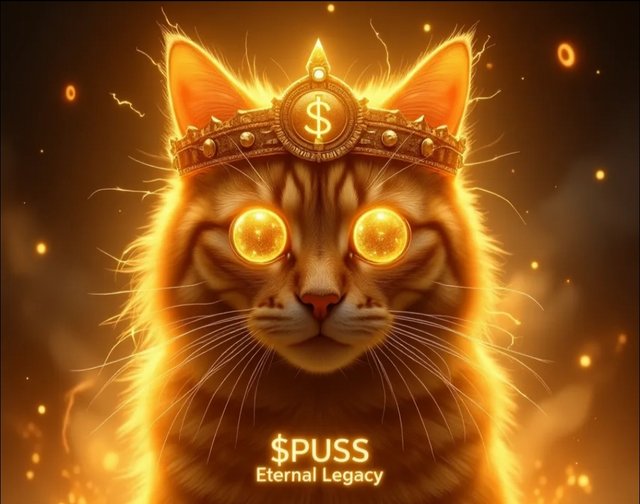How Whales Impact PUSS Coin Price Movements
INTRODUCTION
Whales are instrumental in molding $PUSS Coin’s market behavior. Their vast-volume trades and exchange strategies produce trends that impact prices and trader reasoning. Whales achieve this by placing buy walls and sell walls, which makes retail traders respond irrationally. When you know how this works, you will realize that more frequently than not, price directions don’t emerge naturally from trading.
The best way to forecast $PUSS Coin is to monitor whale wallets. Capital deposits or withdrawals provide the signals of impending dumps or accumulation periods, signifying a whale’s entrance into an asset or departure from it. Since whales tend to move before retail investors notice, following their patterns offers valuable insights. So blockchain transparency comes in handy when preparing for and predicting short-term or long-term fluctuations.
Whales reduce the supply in circulation, by owning massive amounts of coins and tokens. They quietly accumulate when there is no volume, accumulating before bull markets with an increased control over the price direction. And that’s dangerous yes but also a huge opportunity if you are a smart enough trader. By recognizing these behaviors one will be able to understand $PUSS Coin’s market dynamics.
WHALES INFLUENCE EXCHANGE ORDER BOOKS BY SETTING BUY/SELL WALL
Whales can artificially create ‘walls’ in exchange order books by placing extremely large buy or sell orders. By doing so they affect trader psychology into thinking that the price will not go past certain levels. This way whales can control short-term trends in their favor and overall market sentiment.
Buy walls give a perception of strong
support. It’s telling small traders that the price won’t go below this mark, take up your positions and buy with confidence kind of thing. Whales can easily remove these buy orders, tricking others while preparing to reverse the market for personal advantage.
Similarly, sell walls make retail (smaller) traders think that the price can't go over the given point, so that they won't buy and people who have weak hands will sell. Right after the market reaction whales will remove this type of sell wall and take the price to another level. It works with psychological pressure and order book power.
TRACKING WHALE WALLETS GIVES INSIGHT INTO MARKET TRENDS
The transparency of the blockchain means you can easily track whale wallet movements. If there are large transfers of $PUSS Coin to or from an exchange, it can often be a sign that a dump or pump is imminent. Basically because exchanges will always be one of the first things that whales interact with if they decide to cash in their holdings or make a big purchase. Many strategies for identifying and anticipating future trends in trading depend on access to better-data or faster information than everyone else can get. In the case of $PUSS, a lot of that data is available for free.
Whale-watching platforms track movements of big wallets in real time. When huge transactions occur, small-time investors can see in advance what’s coming up in the market. If money is being pulled out regularly, you can expect growing confidence about future prospects; if heavy deposits are occurring, be cautious—it’s liable to be followed by downward movements .
Whale tracking does not guarantee perfect predictions but act as a useful strategy. Whales move first and then retail traders pile on after them; so their behavior is an early indicator of shifts in market confidence. Following whale activity provides a competitive edge in anticipating potential volatility in the $PUSS Coin ecosystem.
LARGE HOLDINGS REDUCE AVAILABLE CIRCULATING SUPPLY
When whales hold a large percentage of $PUSS Coin, less tokens circulate the market. This reduced supply can drive price when demand hits. Retail investors are restricted with minimal availability and usually having to contend over lesser amounts released. Whales create scarcity indirectly hence why they can dictate the direction of the market.
This scarcity effect can go so far as to drive hype and FOMO, bringing in new buyers at even more inflated prices. Meanwhile since whales own the lions share they benefit most from price increases, and their choice to hold or release coins governs just how high prices rise and fall.
Yet over-concentration also poses an acute risk, if whales should choose to sell their stake the influx of tokens available will crash market value suddenly. This double sided feature as both stabiliser and destabiliser paints whales as central figures in $PUSS Coin’s ecosystem, with investors ever cautious about the whale-governed supply and its implications.
WHALES MAY ACCUMULATE SILENTLY BEFORE A BULL RUN
Whales like to accumulate coins under the radar, and they accomplish it best when the markets are silent, so-called low volume. By avoiding arousing suspicion, they can buy in slowly over an extended period of time, months or even years while prices stay relatively flat. Later, they benefit greatly when the bull run begins.
During accumulation, whales typically spread their purchases across different exchanges and timeframes, which makes it look like regular trading. Retail traders will not see it until the fact that whales have already accumulated a big chunk of $PUSS Coin. By then, when rally comes, they can profit like no others.
This is why checking on whale wallets and any potential fishy activities in the market is important. Once again, suspiciously big buys during low volume is usually a sign for accumulation. However this time around, if retail investors can notice it earlier than most of other people as well so they will gain first mover benefits. Based on whales’ strategy and timing during such an accumulation phase often determine the precision and strength of the upcoming rally, giving them market dominance.
CONCLUSION
Whales have a direct influence on $PUSS Coin’s price action by means of order book manipulation, wallet movements, orchestrating supply shocks and stealth accumulation. The psychology they create affects trader sentiment, liquidity and longer term value. You can get burned following the whales but knowing how they work allows retail investors to see the wave building and exit before it crashes.



https://x.com/Memephiz148421/status/1964767598501089730
https://x.com/Memephiz148421/status/1964767342078132386
https://x.com/Memephiz148421/status/1964766275164574114